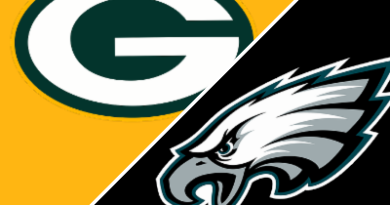Bounce-back picks: Defensemen to draft
Just like the forwards, there are defenders that will experience a lull in their fantasy careers, only to return once again to prominence. But given the current crop of blue-liners that experience a valley in their fantasy production, the relevant question as we head into the 2024-25 season will be: Is that decline permanent?
Using only players with a career 1.7 fantasy points per game (FPPG) threshold, there have been 41 different defenders in the past 15 seasons that have experienced at least a 0.35 FPPG drop from season to season, only to then later bounce back to above their career average in a subsequent season. A couple of them have done it more than once.
It’s a lesser total than the forwards that have experienced the same dip. Defenders tend to be a little more stable, which makes sense as they typically have more counting stats driving their fantasy points (hits, blocked shots). But just 41 managing to bounce back since 2009-10, at scale, isn’t a lot. In that same 15-season span, 239 unique defenders have finished top-60 among their peers in fantasy points.
To identify trends, let’s have a closer look at some of the successful bounce-back seasons in recent memory.
If you want to jump ahead to see our top picks, click here.
In Justin Faulk‘s final season with the Carolina Hurricanes in 2018-19, he posted 1.81 FPPG (against his career mark of 1.77). His first campaign with the St. Louis Blues in 2019-20 saw him plummet to 1.22 FPPG and drop from fantasy rosters. But Faulk returned with a vengeance in 2020-21 with 1.85 FPPG. While we might point to a change in defense partner, Alex Pietrangelo played with him in the down season and Torey Krug in his bounce-back campaign — both quality defenders. His ice time might have been the biggest factor, having dropped to 20:34 in his first season with the Blues, but then back up to 24:16 in 2020-21.
Kris Letang has had multiple yo-yo seasons in his career. He has a 2.25 FPPG mark overall. In 2012-13, he posted 2.66 FPPG, dipped to 2.15 in 2013-14 and then was back up to 2.45 in 2014-15. Similarly, he managed 2.46 in 2016-17, dropped to 1.99 in 2017-18 and was back up to 2.62 in 2018-19. Of course, he only managed to play 72% of all possible regular season games in that span, so some injuries surely played a role. Morgan Rielly has similarly oscillated with his FPPG, posting 1.78, 2.29, 1.77, 1.70, 2.02, 1.78 and 2.37 since 2017-18. He’s been a bit healthier in that span than Letang, playing in 89% of games.
Dennis Wideman had a career 1.88 FPPG mark, but topped it in the lockout-shortened 2013 season with 2.14 FPPG, his first season with the Calgary Flames. The next season was marred by injuries, including a broken hand, as he stumbled to 1.77 FPPG and the Flames finished at the bottom of the standings. The next season, Wideman posted 2.50 FPPG and the Flames soared into the second round of the playoffs. We see a bit of a combination here of injuries and team value playing a role in Wideman’s resurgence.
MacKenzie Weegar is an example of needing some adjustment time with a new team. He had 2.13 FPPG in 2021-22 with the Florida Panthers, then dropped to 1.61 FPPG in his first season with the Calgary Flames. Then, last year, he fired back up with 2.69 FPPG.
This is all to say that there isn’t a precise formula here for why FPPG production will drop and then return.
When it comes to current players that saw a nosedive in FPPG last season, three stand out because there are key qualities they share: They have had epic fantasy careers and are getting older. Is this a dip or has the decline become steady and permanent?
When looking for a dip we are comparing last season’s FPPG to the combined FPPG from the 2021-22 and 2022-23 seasons.
Starting your own league is easier than ever! Set your league size, select your keepers, and invite your friends to start playing. Sign up for free today and be the commish!
The big ones
Erik Karlsson, D, Pittsburgh Penguins (2021-23 FPPG: 2.23, last season FPPG: 1.83): We’ll start with Karlsson, who is the youngest of our three major fantasy drop-offs from last season at 34. From 2013-14 to 2016-17, across all four seasons, only Alex Ovechkin had more fantasy points among skaters (and it was only one more fantasy point; 847.1 for Ovechkin and 846.1 for Karlsson). Then Karlsson became ordinary while battling through injuries for a lot of the next five seasons, only to come roaring back with his Norris Trophy-winning 2022-23 campaign that saw him finish 11th among skaters for fantasy points. The trade to the Penguins then had us hopeful he could continue to stunt on opposing teams while playing with a stronger supporting cast. Well, we all know how that went; the Penguins power play dried up and they missed the playoffs just like the San Jose Sharks.
So what now? Well, we need to talk about the next player, too.
Kris Letang, D, Pittsburgh Penguins (2021-23 FPPG: 2.39, last season FPPG: 1.98): At 37 years old, Letang also dipped in fantasy production last season. Well, at least in FPPG. Last season was the first time since the 2017-18 season that Letang dipped below 2.0 FPPG — even if only by a little. Letang ceded his longtime role as the Penguins power-play quarterback to the arriving Karlsson, but still finished with more fantasy points because the advantage struggled.
So the questions are: Can these two veteran Pens defenders help rebound the team, the power play and, as a result, themselves? And where should we draft them in fantasy?
The first thing to note is that the number of D that manage to finish among the top 60 at their position in fantasy points at age 35 or older has been limited to just 66 players since 2009-10. And it’s only 41 if you also filter for them among the top 100 skaters overall. If we go to Letang’s age, it drops to only 16 D that have managed top-100 seasons at 37 or older in the past 15 years — and that includes Letang himself last season, when he finished 65th.
So Karlsson is the preferred option of the two, no doubt. There is some upside here if the Penguins power-play struggles can be confined to last season. Perhaps Karlsson follows the bounce-back path of Weegar — as in, he just needed a season to adjust to his new surroundings and will go right back to world-beating again. Surely part of this offseason was the Pens coaches planning for how to get Karlsson, Sidney Crosby and Evgeni Malkin to have chemistry when it’s five-on-four. Karlsson should be considered at drafts near the very top of the second tier of defense — so when the likely top 12 are clearly off the board — as there is still a lot of potential reward.
As for Letang, well, he’ll probably still be a serviceable fantasy asset, but the upside is no longer there with Karlsson taking the helm on the advantage.
Verdict: Karlsson is still safe to keep or draft in fantasy, but don’t be overly hasty thinking Letang still has fantasy goods in the tank.
Want a challenge? Sign up for an ESPN+ league and face off against the best of the best!
Brent Burns, D, Carolina Hurricanes (2021-23 FPPG: 2.06, last season FPPG: 1.58): Which brings us to Burns, who will turn 40 before the end of the season. When it comes to defenders posting a top-100 fantasy season at age 39 or older in the past 15 years, here’s the list: Nicklas Lidstrom twice, Zdeno Chara twice and Sergei Gonchar once. Of those five seasons, only Lidstrom’s 2010-11 campaign was better than 68th overall. So for Burns to slip below fantasy relevance last season and then bounce back in a significant way sounds pretty far fetched.
But here’s the thing: the Hurricanes will still have a dangerous power play and Burns still has a chance to anchor it. The Hurricanes may end up going with Shayne Gostisbehere as a specialist on the advantage, but they had Tony DeAngelo last season to play a similar role and still went with Burns for the vast majority of minutes. That really is the rub though; Burns or Gostisbehere will have some fantasy value this season, probably not both. For my draft value, I’m going with Gostisbehere.
Verdict: You probably won’t regret not having Burns on your roster this season.
Some others
Devon Toews, D, Colorado Avalanche (2021-23 FPPG: 2.02, last season FPPG: 1.75): This might just be a case of an inflated FPPG from one season making Toews appear as though he’s dipped in production. His 13-goal, 57-point career year in only 66 games in 2021-22 really pops his FPPG chart, but in reality he’s finished each of the past three seasons with between 139 and 155 fantasy points, which is a fair projection going into another season with Cale Makar as his defense partner.
Adam Larsson, D, Seattle Kraken (2021-23 FPPG: 1.82, last season FPPG: 1.57): Coming into his own as a shot-blocking hero in 2020-21, Larsson reeled off three seasons of fantasy relevance, finishing between 64th and 113th overall in fantasy points until last season, when he dropped to 170th. Still 31 years old to start the season, Larsson just re-upped on a four-year extension with the Kraken. He’ll still get heavy minutes and is a good bet to bounce back to his fantasy relevant ways.
Aaron Ekblad, D, Florida Panthers (2021-23 FPPG: 2.07, last season FPPG: 1.41): It’s been easy to be down on Ekblad of late, as injuries and other players have pushed him down the depth chart. But the timing has never been better for a resurgence. Still squarely in his prime at 28, Ekblad has been handed a reprieve by the two players ahead of him on the power-play depth chart getting squeezed out of Florida; Brandon Montour signed in Seattle and Oliver Ekman-Larsson in Toronto. He’s currently head and shoulders the best option for the advantage. If Ekblad can stay healthy, this could finally be that career year we’ve been waiting for.
Tony DeAngelo, D, (free agent) (2021-23 FPPG: 1.82, last season FPPG: 0.99): There are minimal options left for DeAngelo to find a home that would both give him playing time and make him a fantasy asset, despite the fact he still has potential as a power-play specialist. DeAngelo would need the right combination of a team that can afford to give him minimal even-strength minutes and is still in need to a potential lift to the advantage. A short list of quality landing places might be limited to the Sharks and maybe, if you want to suspend disbelief, the Minnesota Wild or Panthers. Everyone else already has a defensive group that would probably face subtraction by his addition.
Tyson Barrie, D, (free agent, tryout with Calgary Flames) (2021-23 FPPG: 1.67, last season FPPG: 1.23): Even if Barrie does make the Flames roster, he would need power-play time to reach his fantasy potential. It’s hard to envision that with Weegar and Rasmus Andersson as options.
If you’ve made it this far, take the next step and sign up for ESPN Fantasy hockey. Download the ESPN Fantasy app today!



